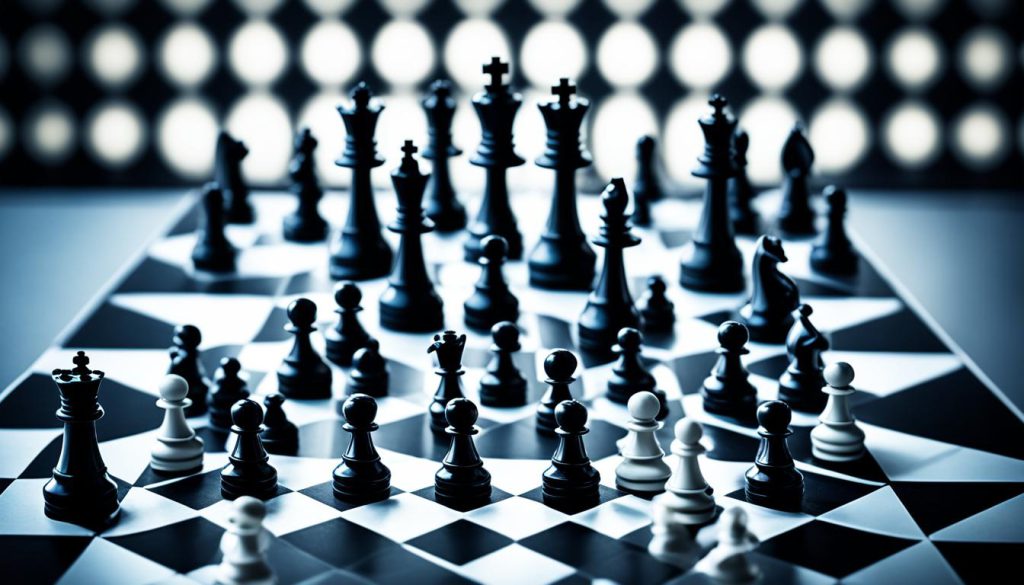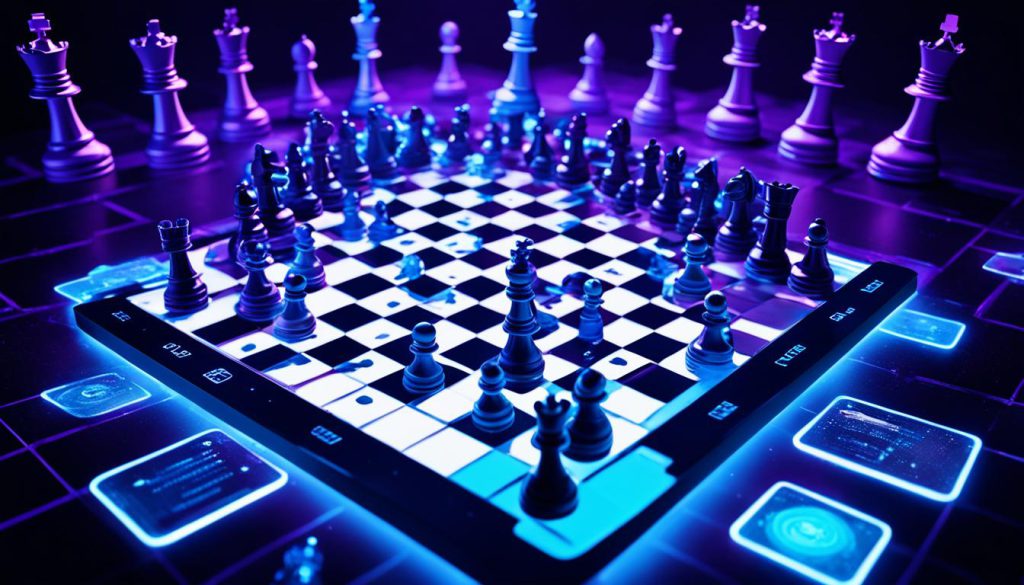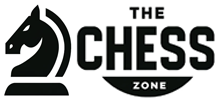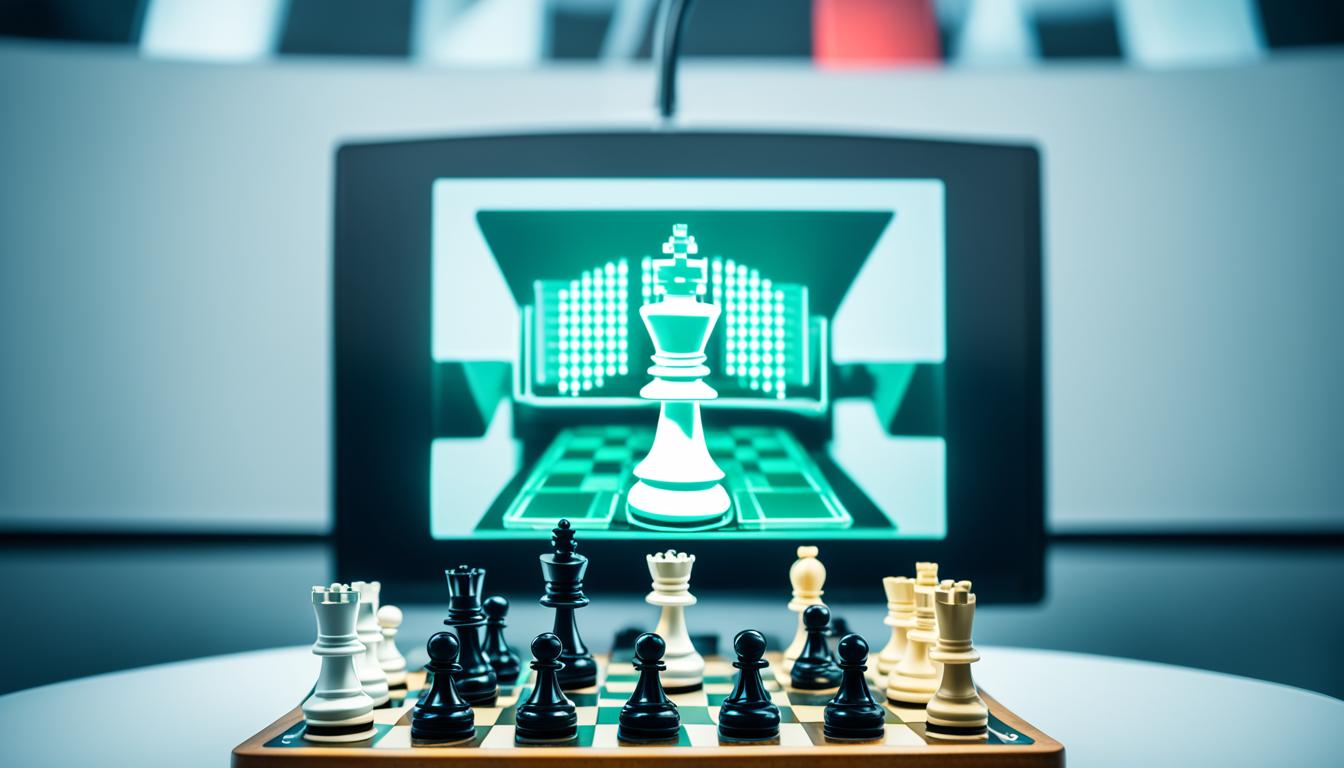“In the field of observation, chance favors only the prepared mind.” – Louis Pasteur
Chess rewards those who prepare well and can adapt. Players aiming for high titles like National Master or Grandmaster use many training methods. These methods help them improve their game.
Different techniques help players master chess. They include studying openings, analyzing games with engines, and learning endgame theory. Computer-assisted methods have changed how players approach training. They make it easier to understand complex strategies.
Being able to remember new information is important for players. It helps them recognize patterns quickly. This skill is crucial for becoming better at chess.
Key Takeaways
- High-level chess players use a variety of training methods to enhance their skills.
- Computer-assisted chess plays a significant role in modern training techniques.
- Integrating new information into schemas is crucial for effective pattern recognition.
- Training practices include opening preparation, game reviews, tactics exercises, and endgame theory.
- The evolution of AI has significantly impacted chess training and strategy development.
Introduction to Computer-Assisted Chess Training
Technology has changed chess training a lot. This introduction to chess computer training looks at how digital tools and AI change the game. Old study ways now mix with new software to get better at chess. AI platforms give personalized plans and deep analysis for each player’s goals.
Chess engines have grown a lot over time. In 2019, the Lc0 engine became the top chess engine in the world. It won the Chess.com Computer Chess Championship. Since 2016, Stockfish has been a leading engine. Stockfish’s power and Komodo’s unique ideas, from GM Larry Kaufmann, make engines better than human players.
AlphaZero by DeepMind is another big name in digital chess learning. It beat Stockfish in a big match in 2017. Houdini is also good, especially in fast games. These engines are tough to beat and great for learning. For example, Lc0 learns by playing millions of games against itself. Open-source engines like Ethereal and Laser are good learning tools too.
A chess learning program with these engines helps a lot. It gives feedback and advice right away, for what each player needs. Digital tools help players see many scenarios. This lets them learn complex moves and game positions better.
These methods use neural networks and deep learning. They’re key to modern chess learning. Using these technologies can greatly improve your chess skills. It makes becoming a chess master more possible than ever.
Role of AI in Chess Training
Artificial intelligence in chess has changed how we train significantly. AI helps players, including top Grandmasters, improve their game. Over 95% of players rated above 2700 by FIDE use AI to review their games and try out recommended moves.
Programs like Stockfish lead in computer chess. AlphaZero, built on deep neural networks and Monte Carlo Tree Search, showcases AI-powered chess analysis. Impressively, AlphaZero beat Stockfish in 100 games, with 28 wins and 72 draws, all after just four hours of learning by playing itself.
Leela Chess Zero (LC0) uses deep and reinforcement learning to get better from its own games. Chess.com’s Mittens, an AI bot, has an impressive rating and won 99% of its games against humans.
AI gives personalized tips, showing players how to get better. This makes learning complex strategies easier and helps understand game positions very well. Thanks to this, ai chess training is more effective than it used to be.
AI in chess has come a long way since the 1940s and 50s. Today, hybrids of humans and computers, or cyborgs, are tough to beat. They mix databases of past games with human thinking for the best choices.
Below is a comparative analysis of some top AI chess engines:
| Chess Engine | Strength | Key Techniques |
|---|---|---|
| Stockfish | Top-rated and Championship Winner | Alpha-Beta Pruning, Heuristic Evaluations |
| AlphaZero | Defeated Stockfish | Deep Neural Networks, Monte Carlo Tree Search |
| Leela Chess Zero (LC0) | Highly Adaptive | Deep Learning, Reinforcement Learning |
| Mittens | Elo Rating 3200-3500 | Unknown |
With these tools, players get a deeper insight into chess. They can critically review their games. Thus, AI chess training is a key resource for those aiming at mastery.
Types of Chess Training Software
Advanced tools greatly improve your chess skills. Different chess training software focuses on game aspects. These include interactive tutorials, tactical trainers, and positional analysis tools.
Many players use chess software tutorials to learn new strategies. These tutorials provide simple, step-by-step instructions. The interactive chess learning they provide makes improving fun and engaging.
Interactive Tutorials
Interactive tutorials are a hit with beginners. About 70% of them choose these tools for their ease of use. They mix visual aids and hands-on exercises well.
This helps players understand important ideas quickly. This type of chess software tutorial improves learning with immediate feedback and tracking.
Tactical Trainers
For quick tactical plays, chess tactics trainers are key. They boost the ability to recognize patterns. This is vital for making smart moves in games.
About half of all chess programs focus on these tactics. This shows how crucial they are for mastering chess.
Positional Analysis Tools
To master chess positions, chess positional tools are critical. They help explore positional play deeply. Players can analyze moves with top-level software accuracy.
Tools like Fritz, Rybka, or Hiarcs hold a 35% market share. This is among professional chess training software.
| Training Aspect | Percentage Focus | Key Tools |
|---|---|---|
| Interactive Tutorials | 70% | Fritz, Hiarcs |
| Tactical Trainers | 50% | Rybka, ChessBase |
| Positional Analysis Tools | 35% | Fritz, Hiarcs |
Also, many interactive chess learning methods mix these parts. This creates a well-rounded training plan. It sharpens various skills, preparing players for any challenge on the chessboard.
Chess Computer Training
Chess computer training has changed how players learn and improve. Using a chess learning program combines brain challenges with advanced technology. This mix helps players grow in a fun and effective way.
Rybka 4 is a top pick for chess computer training. Released in 2010, it plays like a human, giving a real game feel. It also sharpens your strategy skills with its game analysis.
For affordable chess learning, try the TASC Chess CD 2. It offers over 50 hours of beginner lessons for less money. This makes it easy to improve step by step.
Chess software programs are great for learning. With regular practice, beginners can become much better. These programs improve your thinking and strategy skills. They make learning chess balanced and enjoyable.
Practicing playing tactics can quickly boost your chess skills. Technology-enhanced chess practice lets you compete with players everywhere. It also offers cool visuals and unique chess sets to make playing fun.
For best results, use training software and play real games too. This mix enhances your learning and playing. It lays a strong foundation for strategy and actual game skills.
Below is a table comparing two main chess training programs:
| Software | Key Features | Training Hours | Cost |
|---|---|---|---|
| Rybka 4 | Human-like play, Game Analysis | NA | High |
| TASC Chess CD 2 | Comprehensive Beginner Instruction | 50+ hours | Low |
Whether you’re a newbie or want to get better, chess computer training can help. Mixing software with actual play improves your strategy skills. It’s a smart choice for anyone wanting to excel at chess.
Online Chess Lessons
Online chess lessons offer a great way to get better at chess. They fit your schedule and your level, from beginner to advanced. There’s something for everyone in the vast array of online resources.
Live Coaching Sessions
Live coaching provides a personal touch to learning chess. In live coaching sessions, you interact with experienced coaches. They give you feedback right away. This immediate response helps clear up any confusion and builds strategies tailored to you. For instance, Chess University’s course on Udemy has been a big hit, drawing in 20K learners.
| Course | Provider | Enrollments | Rating |
|---|---|---|---|
| Intro To Chess Crash Course | Chess University (Udemy) | 20K | 4.7/5.0 |
| Chess Tactics | Tryfon Gavriel (Udemy) | 8.8K | 4.5/5.0 |
| Kids Learn Chess the Fun & Easy Way! | Mike Klein (Udemy) | 32K | 4.6/5.0 |
Pre-recorded Video Lessons
Pre-recorded chess lessons are super convenient. You can learn at your speed and go back over the hard parts anytime. Platforms like MasterClass feature courses by chess legends—like Garry Kasparov. On Udemy, 5K students have signed up for Mykhaylo Oleksiyenko‘s course on chess openings.
With both free and paid courses available, there’s something for all budgets and preferences. The total of 65.8K enrollments shows how popular and effective online chess lessons are.
Cognitive Load Theory in Chess Training

Grasping cognitive load theory is key for improving chess training. This theory focuses on creating and using schemata in our long-term memory. This boosts a player’s skill in navigating complicated game scenarios. Studies show working memory can handle about seven chunks of information.
The number of chunks we can process drops to 2 or 3 when busy. Chess masters manage by memorizing board setups as chunks. This includes groups of pieces for better thinking efficiency. By practicing a lot, players make tasks automatic. This frees up mental space for strategy planning.
Learning is most effective when instructional materials align with cognitive architecture.
For new players, clear instruction is vital for building knowledge structures. Repeating and simplifying ideas help form schemas. According to chess psychology, learning simple, repeated methods is key to understanding complex issues. The table below shows how different factors affect chess learning capacity.
| Aspect | Impact on Learning |
|---|---|
| Cognitive Load Theory | Enhances instructional alignment |
| Repetition | Speeds up schema formation |
| Simple Methods | Aids in understanding and simplification |
| Working Memory Capacity | Limits processing to 2-3 chunks |
Matching chess teaching to these ideas helps students tackle harder situations over time. This enhances their chess skills and overall learning. This strategy also boosts their immediate game and long-term excellence. It uses the core of cognitive load theory and chess cognitive psychology.
Deep Learning and Chess Engines
Deep learning has made chess engines much smarter. By using huge datasets, these engines can now check countless positions very accurately. These datasets often use Stockfish to evaluate chess positions. They show if White or Black is winning through a score. All this info is stored in a big 3D matrix that represents the chessboard.
These engines typically use a Convolutional Neural Network (CNN). This network is designed to understand complex chess data. I have tested them in various matches. These include AI against Stockfish, AI against another AI, and AI against humans like me. Interestingly, these tests show the AI’s strength might be about 600 Elo or even less. Yet, their ability in chess strategy and tactics is still impressive.
Engines like AlphaZero and Leela Zero have raised the bar in AI chess. AlphaZero beat Stockfish in 2017. Leela Zero is a version anyone can use. Stockfish NNUE is also a big step forward in chess AI. The cost to train AlphaZero was said to be around $35 million, showing the huge investment in this tech.
In July 2021, 6% of games on Lichess.com, about 5.5 million games, had Stockfish evaluations. That month, Lichess recorded around 441,600,000 positions. The data for the month took up 25.2 GB of space.
| Statistic | Value |
|---|---|
| Total chess positions in July 2021 | 441,600,000 |
| Stockfish-analyzed games in July 2021 | 5.5 million |
| Compressed monthly shard size | 25.2 GB |
| Project database size | 37 million positions |
The AI model was trained using PyTorch Lightning. This decreased its loss from 1.29 to 1.06 in two versions. The tests involved playing chess with the AI. The average opponent was rated ~1200. The AI took about 20 seconds for each move. The chess engine used by the opponent was simple, under 300 lines of code.
Deep learning and advanced engines are really pushing AI chess forward. They’re changing how we understand and play chess today.
Benefits of Virtual Chess Strategies
Virtual chess strategies have changed how we learn chess. They use modern technology to boost our learning. These methods are great for making chess training better.

Enhanced Learning Experiences
Interactive media and digital tools make virtual chess fun. They help players of all ages, including kids, to start learning easily. These tools make learning about fairness, honesty, and respect fun.
Efficient Time Management
You can practice chess anytime, anywhere with virtual strategies. They give instant feedback and focused training. This makes learning fit into a busy life easily. It’s great for seniors, helping them stay sharp and fight dementia.
Personalized Training Programs
Virtual chess offers training that fits you perfectly. The training changes to match how you learn and play. This means you can learn complex strategies at your own speed. These programs make learning chess better for everyone.
Computer-Based Chess Coaching
Chess training has changed with computer-based coaching. Special software and digital platforms help. They use tools to analyze moves and large databases. This way, coaches can create lessons just for you.
There are many plans to choose from:
- Standard Plan: Offers 40 game analysis reports per month and a weekly personalized study plan — at no cost.
- Premium and Annual Premium Plans: Provide unlimited analysis reports, the last 1000 online games review, and unlimited daily training sessions. They help you grow steadily.
Here’s what each plan costs:
| Plan | Cost | Features |
|---|---|---|
| Standard | Free | Basic reports and weekly study plans |
| Premium | $7.99/month | Unlimited reports, deeper analysis, daily training |
| Annual Premium | $4.85/month or $57.99 annually | All Premium features at a discounted annual rate |
Different ways to pay for these plans include credit cards and Paypal. Google Pay will be added soon. It’s easy to change or cancel plans. This makes it easy to manage your budget.
Digital chess lessons are great because they’re easy to get and always getting better. Places like Aimchess offer advice that applies to many situations, not just single moves. This makes them better than old-school methods.
If you need more help, just email their customer support. They give personalized help for all kinds of questions. This makes sure you have a great experience.
Challenges and Limitations
Technology has changed chess training a lot. But, it comes with its own challenges. One big issue is relying too much on AI. This might stop players from really understanding the game. Even though AI is super helpful, it sometimes misses the subtle parts of human chess, showing the limitations of AI chess training.
Also, there are so many tools and data out there. It can be overwhelming. Players might not know where to start because of too much information. This is a big digital training pitfall. Especially for young players between 14 to 20 years old getting ready for the National Games. They feel a lot of pressure and need special training to compete well, especially if they’re rated between 1200-1800.
There are bright spots, though. Like the Computer Workout. It’s updated with 220 new positions for all levels: beginner, intermediate, and advanced. But, managing how long you train is key. Beginners should spend about 30 minutes, while advanced players might spend 1-2 hours on harder parts. This tool helps with everything from simple checkmates to tough endgames, showing the importance of focused practice.
To avoid these training issues, it’s important to have personal study programs. ChessBase and the Mega Database 2022 are very important for learning about games. But, you must stick to a plan. For players rated 1400-2000, checking their progress weekly with online help is really helpful. It helps improve their skills, not just their knowledge.
Conclusion
The journey in modern chess training mixes new technology with smart learning strategies. The updated Computer Workout brings a big change. It swaps out old challenges for 220 new ones. These cater to different skill levels, making sure everyone gets a shot at improving. Beginners might spend 30 minutes, while advanced players could tackle complex tasks for up to 2 hours.
The structure splits into seven categories, like basic checkmates and managing material advantage. This setup creates a clear path for learning. Beginners and those at an intermediate level work on winning. Advanced players aim to understand when and how to push for a win. This helps players build a full range of skills, paying attention to both attack and defense.
Plans to add more levels show a dedication to making training even better. In closing, blending computer tools with old-school methods ensures a well-rounded chess education. This combination benefits from AI, yet keeps the game’s strategy at its heart. For the latest in chess training, check out Computer Workout 2.0.
Source Links
- https://www.forbes.com/sites/forbestechcouncil/2022/01/07/why-computer-assisted-humans-are-the-best-chess-players-and-what-that-means-for-technology-operations/
- https://en.wikipedia.org/wiki/Computer_chess
- https://www.codemotion.com/magazine/ai-ml/the-ultimate-checkmate-ai-and-chess-engines/
- https://www.chess.com/article/view/computer-chess-engines
- https://cs.uwaterloo.ca/~alopez-o/divulge/chimp.html
- https://www.capturehighered.com/machine-learning-vs-ai-when-machines-play-chess-like-humans/
- https://www.chessusa.com/category/chess-software-books-videos.html
- https://blog.chesshouse.com/what-is-the-best-chess-software-to-learn-chess/
- https://www.classcentral.com/report/best-chess-courses/
- https://www.chess.com/forum/view/general/cognitive-load-and-chess-training
- https://www.mindbrained.org/2021/08/cognitive-load-theory-and-the-differences-between-experts-and-novices-what-chess-tells-us-about-teaching-foreign-languages/
- https://medium.com/@nihalpuram/training-a-chess-ai-using-tensorflow-e795e1377af2
- https://towardsdatascience.com/train-your-own-chess-ai-66b9ca8d71e4
- https://edpsych.umn.edu/news/why-you-should-consider-learning-chess-online
- https://chessarena.com/news/all/how-online-chess-can-help-beginners-improve-their-over-the-board/
- https://summitschoolofchess.com/learn-chess-online/
- https://aimchess.com/
- https://www.chess.com/news/view/computer-workout-20
- https://en.chessbase.com/post/key-challenges-trainers-2

